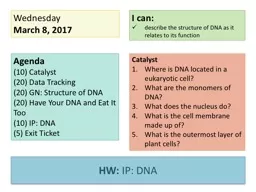

10 Catalyst 20 Data Tracking 20 GN Structure of DNA 20 Have Your DNA and Eat It Too 10 IP DNA 5 Exit Ticket I can describe the structure of DNA as it relates to its function ID: 912317
Download Presentation The PPT/PDF document "Wednesday March 8, 2017 Agenda" is the property of its rightful owner. Permission is granted to download and print the materials on this web site for personal, non-commercial use only, and to display it on your personal computer provided you do not modify the materials and that you retain all copyright notices contained in the materials. By downloading content from our website, you accept the terms of this agreement.
Slide1
WednesdayMarch 8, 2017
Agenda(10) Catalyst(20) Data Tracking(20) GN: Structure of DNA(20) Have Your DNA and Eat It Too (10) IP: DNA(5) Exit Ticket
I can:describe the structure of DNA as it relates to its function
CatalystWhere is DNA located in a eukaryotic cell?What are the monomers of DNA?What does the nucleus do?What is the cell membrane made up of?What is the outermost layer of plant cells?
HW:
IP: DNA
Slide2WednesdayMarch 8, 2017
Agenda(10) Catalyst(20) GN: Structure of DNA(10) DNA Extraction Demo(25) Have Your DNA and Eat It Too (20) IP: DNA(5) Exit Ticket
I can:describe the structure of DNA as it relates to its function
CatalystWhere is DNA located in a eukaryotic cell?What are the monomers of DNA?What does the nucleus do?What is the cell membrane made up of?What is the outermost layer of plant cells?
HW:
IP: DNA
Slide3Slide4Slide5DNA has to be able to:
Store hereditary information in some sort of code.Be easily and accurately copied, as a copy is passed on every time a cell divides. What properties of DNA allows it to do so?
Slide6The unique structure of DNA allows it to be the hereditary molecule and allows it to store instructions for directing cell activities.
Slide7DNADNA stands for deoxyribonucleic acid. It is a long molecule made up of monomers called nucleotides.
Each nucleotide is made of 3 parts:a 5-carbon sugara phosphate group
a nitrogenous base
Slide8DNA Structure
The structure of DNA is often described as a double helix, or twisted ladder.
Slide9The rungs of the ladder are formed by the four
nitrogen bases and are held together by weak hydrogen bonds.
a single nucleotide
The backbone of DNA is formed by alternating sugar and phosphates held together by a strong bond.
Slide10Think Box 1:
What does DNA look like?
What forms the
“
backbone
”
of DNA?
Where are the weak bonds in DNA?
Where are the strong bonds in DNA?
Why do you think DNA is important?
Slide11Nitrogenous BasesDNA contains four nitrogenous bases:adenine (A)thymine (T)cytosine (C)guanine (G)
The order of these bases determines the genetic code.
Slide12Base-Pairing RulesThe bases of DNA pair with each other in a predictable way.
A always pairs with TC always pairs with GDNA is said to be complementary – each strand can be used as a template for the other half using the base-pairing rules.
Slide13Guided PracticeOne strand of DNA has the base sequenceT A C G A T T G AWhat is the complementary strand of DNA?
A T G C T A A C T
Slide14Guided PracticeWhat is the DNA sequence complementary to the one shown below?A A C T G C C T A
T T G A C G G A T
Slide15Think Box 2:
What determines the message that DNA contains?
What do the base-pairing rules of DNA say? What always bonds with each other?
If one half of DNA reads ATCGATC, what will be the order of letters in the other strand?